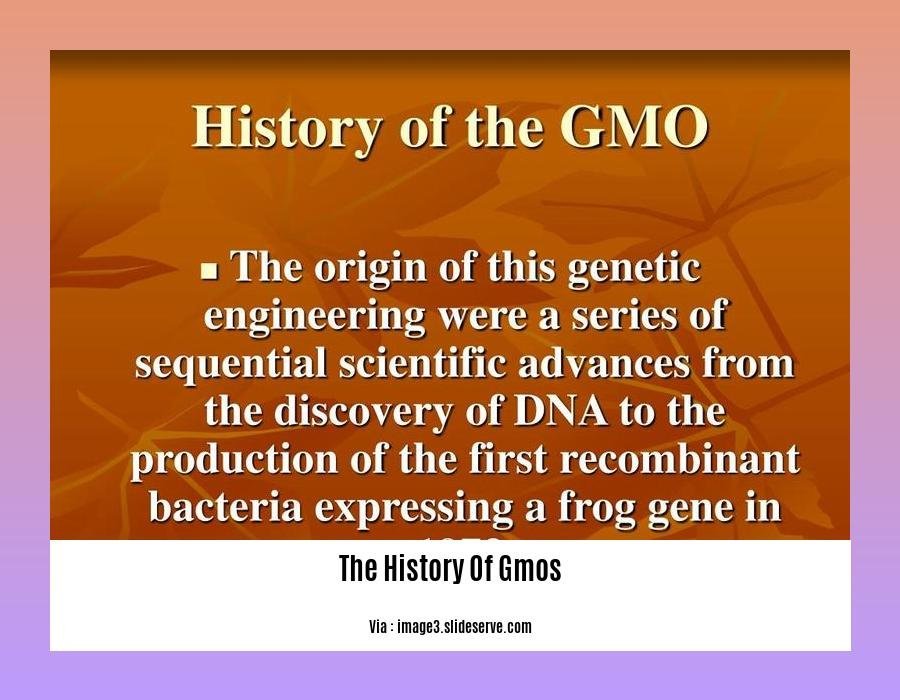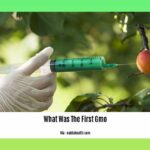Explore the fascinating journey of Genetically Modified Organisms (GMOs) in [- The History of GMOs: From the Lab to the Farm]. From their humble beginnings in the laboratory to their widespread applications in agriculture and medicine, this article delves into the development, controversies, and potential of GMOs, offering a comprehensive overview of these groundbreaking creations.
Key Takeaways:
- Genetic Engineering Revolutionizes Biology:
The development of genetic engineering techniques has transformed the field of biology, allowing scientists to precisely manipulate DNA.
FDA Approval of GMO Food and Crops:
The US FDA has approved the use of GMO food products, crops resistant to herbicides and insects, and even a GMO animal.
Debate and Discussion on GMOs:
The introduction of GMOs has sparked debates and discussions surrounding their benefits, regulatory frameworks, and potential risks.
Continuous Evolution of Genetic Engineering:
The field of genetic engineering continues to evolve, leading to ongoing discussions about the use and impact of GMOs.
References:
- National Geographic: Genetically Modified Organisms
- FDA: Timeline of Genetic Modification in Modern Agriculture
The History Of GMOs: A Journey from Discovery to Application

In the realm of modern biotechnology, genetically modified organisms (GMOs) hold a prominent place, profoundly transforming various industries and stirring up conversations around their impact on our lives and our planet. The History of GMOs is a captivating narrative of scientific discovery, technological advancements, and societal discourse.
Unraveling the History Of GMOs
The roots of genetic modification can be traced back to ancient breeding practices employed by farmers, where selective breeding techniques were used to enhance desirable traits in plants and animals. However, it wasn’t until the 1970s that genetic engineering techniques gained momentum, opening up a new frontier in organism manipulation.
1973: A Seminal Moment in Genetic Engineering:
In 1973, a significant breakthrough occurred when scientists achieved the creation of the first recombinant DNA molecule, merging DNA from distinct organisms. This milestone paved the way for the genetic modification of organisms through the integration of DNA from different sources.
1982: Initial Approval for GMOs in Food Production:
The 1980s witnessed a pivotal moment when the US Food and Drug Administration (FDA) granted approval to the first genetically modified food product – a bacterium engineered to produce insulin. This decision marked a historic turning point, ushering in the era of GMOs in food production.
1994: The Debut of GMO Crops:
The year 1994 marked the commercial introduction of the first GMO crop – the Flavr Savr tomato. This modified tomato exhibited a delayed ripening trait, extending its shelf life. This marked a significant step forward, paving the way for the expansion of GMOs in agriculture.
1996: Enhancing Crop Resilience:
The mid-1990s saw the introduction of GMO crops resistant to herbicides and insects, revolutionizing agricultural practices. These crops offered increased crop yields and reduced the need for chemical pesticides, reshaping the agricultural landscape.
2015: The First GMO Animal:
In 2015, the FDA took another groundbreaking step by approving the first GMO animal – the AquAdvantage salmon. This modified salmon exhibited faster growth rates compared to its wild counterparts, stirring up conversations about the implications of GMOs in animal husbandry.
The Evolving Conversations Surrounding GMOs:**
The History Of GMOs is intertwined with ongoing discussions about their potential benefits, regulatory frameworks, and potential risks. Advocates emphasize the potential of GMOs to address food security, environmental sustainability, and medical advancements. Opponents raise concerns about the potential risks to human health, the environment, and the potential for monopolization in the agricultural sector.
As the field of genetic engineering continues to evolve, so too does the discourse surrounding GMOs. From their initial discovery to their current applications, GMOs have come a long way, shaping industries, igniting debates, and stimulating continuous scientific exploration. The journey of GMOs is far from over, and the future holds countless possibilities for this transformative technology.
Investigate the history of GMOs and uncover the intriguing journey of genetically modified organisms, from their humble beginnings to their global impact.
Discover why GMO foods were created and explore the driving forces behind the development of these engineered crops, aiming to address global food security and agricultural challenges.
Delve into the fascinating story of the first GMO and learn about the groundbreaking scientific advancements that led to the creation of the first genetically modified organism, opening up new possibilities in the field of biotechnology.
Uncover the timeline of when GMO foods were first introduced and trace the historical trajectory of these modified crops, marking significant milestones in their adoption and impact on global food systems.
Explore why GMOs were invented and delve into the motivations and goals that spurred scientists and researchers to embark on the journey of genetic engineering, aiming to address pressing global issues and enhance agricultural productivity.
The Rise of Commercial GMOs

We’ve all heard of GMOs, those organisms whose genetic blueprints have been modified to introduce desirable traits, but do you know how they rose to prominence? Buckle up for a journey through the history of GMOs, from their humble beginnings in labs to their significant presence on our dinner tables.
Key Experiments That Paved the Way
In 1973, scientists created the first genetically modified organism, a bacterium called Escherichia coli, setting the stage for the genetic engineering revolution. Fast forward to 1982, and the US FDA gave the green light to the first-ever genetically modified food product – a bacterium producing insulin, marking a monumental moment.
Commercialization Takes Center Stage
The Rise of Commercial GMOs truly took off in 1994 when the Flavr Savr tomato, the first GMO crop, hit the market. This tomato was engineered to have a longer shelf life, capturing the attention of farmers and consumers alike. Soon after, in 1996, GMO crops resistant to herbicides and insects made their debut, revolutionizing agricultural practices. These crops promised higher yields and reduced the need for chemical pesticides, making them highly sought after.
The Ongoing GMO Debate
While GMOs have undoubtedly transformed agriculture, they’ve also sparked heated debates. Concerns over their potential impact on human health and the environment have been raised, leading to ongoing discussions and regulations. Despite these controversies, GMOs have played a significant role in addressing global food security and agricultural challenges.
Key Takeaways:
In 1973, the first genetically modified organism, Escherichia coli, was created.
The first genetically modified food product, a bacterium producing insulin, was approved by the US FDA in 1982.
The commercialization of GMOs gained momentum in 1994 with the introduction of the Flavr Savr tomato, followed by herbicide- and insect-resistant crops in 1996.
The Rise of Commercial GMOs has led to discussions about their potential benefits (food security, sustainability) and concerns (health risks, environmental impact).
GMOs continue to be a topic of scientific exploration and regulation, with their impact still being studied.
Citation: Science and History of GMOs and Other Food Modification Processes
These 8 GMOs tell a brief history of genetic modification
The GMO Debate: Benefits, Risks, and Controversies
Key Takeaways:
- GMOs, short for Genetically Modified Organisms, have become central to agricultural debates.
- Genetic engineering techniques modify an organism’s DNA to introduce new traits or modify existing ones.
- GMOs are widely used in crops like corn, soybeans, and cotton to enhance yield and resilience.
- The safety and environmental impact of GMOs are subject to ongoing study and regulation.
- The debate surrounding GMOs centers on potential benefits and risks, including food security, sustainability, health concerns, and environmental impact.
GMOs, or Genetically Modified Organisms, have taken center stage in the agricultural arena, sparking fervent debates about their benefits, risks, and implications. Genetic engineering, the technology behind GMOs, allows scientists to alter an organism’s DNA, introducing new traits or modifying existing ones with precision. This has led to the proliferation of GMOs in agriculture, particularly in crops like corn, soybeans, and cotton, with the aim of enhancing yield, resistance to pests and diseases, and nutritional content.
Benefits of GMOs:
- Increased Crop Yield: GMOs can help farmers produce more crops on the same amount of land, potentially addressing global food security concerns.
- Enhanced Nutritional Value: Genetic engineering enables the modification of crops to contain higher levels of essential nutrients, such as vitamins and minerals.
- Resistance to Pests and Diseases: GMOs can be engineered to possess natural resistance to pests and diseases, reducing the need for chemical pesticides and herbicides.
Risks and Concerns Associated with GMOs:
- Potential Allergenicity: There is a small risk that GMOs could introduce new allergens into the food supply, although this is closely monitored by regulatory agencies.
- Environmental Impact: Some critics argue that GMOs may have unintended consequences on ecosystems, such as affecting non-target organisms or promoting the development of resistant pests.
- Long-Term Health Effects: While extensive research has been conducted, some individuals express concerns about the long-term health effects of consuming GMOs, despite the lack of substantial evidence to support these claims.
The Ongoing Debate:
The GMO debate is a complex one, involving scientific, ethical, environmental, and economic considerations. While GMOs have the potential to address global food challenges and improve agricultural practices, concerns about their safety and environmental impact persist. Regulatory agencies worldwide have strict guidelines for evaluating GMOs before approving them for commercial use, ensuring rigorous safety assessments. However, the debate continues to evolve, with ongoing research and discussions shaping public opinion and policy decisions.
Conclusion:
The GMO Debate: Benefits, Risks, and Controversies highlights the complexities surrounding genetically modified organisms. Weighing the potential benefits against the perceived risks is essential in forming informed opinions and guiding policy decisions. Continued research and monitoring are crucial to address concerns and ensure the responsible use of GMOs in agriculture.
Relevant URL Sources:
1. GMOs: Benefits and Risks
2. The Science Behind Genetically Modified Organisms (GMOs)
The Future of GMOs: A Glimpse into the Crystal Ball
We’ve journeyed through the history of GMOs, their inception, and their evolution. Now, let’s peer into the crystal ball and envision what the future holds for these genetically modified organisms.
Key Takeaways:
Heightened Precision, Enhanced Traits: Advancements in gene editing techniques, such as CRISPR-Cas9, promise more precise alterations, enabling scientists to fine-tune desirable traits and minimize unintended consequences.
Addressing Global Challenges: As the world faces food security, climate change, and environmental degradation, The Future of GMOs might lie in engineering crops resilient to extreme weather, pests, and diseases.
Nutritional Powerhouses: GMOs could become nutritional powerhouses, enriched with vitamins, minerals, and essential nutrients, offering solutions to malnutrition and dietary deficiencies.
Biodegradable Plastics, Renewable Energy Sources: GMOs could be harnessed to produce biodegradable plastics and renewable energy sources, potentially reducing our reliance on fossil fuels and promoting sustainability.
Ethical and Environmental Considerations: Continued research and dialogue are crucial to address ethical, environmental, and regulatory concerns, ensuring the responsible and sustainable use of GMOs.
URL Sources:
1. The Future of GMOs: What’s Next? – World Economic Forum
2. The Good, the Bad, and the Hungry: The Future of GMOs – Scientific American
FAQ
Q1: When did the modern era of GMOs begin?
A1: The modern era of GMOs began in the 20th century with the development of genetic engineering techniques that facilitated precise and rapid organism modification by manipulating their DNA.
Q2: What was the first GMO food product approved by the FDA?
A2: The first GMO food product approved by the FDA was a bacterium engineered to produce insulin, which was approved in 1982.
Q3: When was the first commercial GMO crop introduced?
A3: The first commercial GMO crop was the Flavr Savr tomato, which was approved by the FDA and introduced in 1994.
Q4: What are the main applications of GMOs in agriculture?
A4: GMOs are primarily used in agriculture to improve crop yields, enhance pest and disease resistance, and increase nutritional content.
Q5: What are the key controversies surrounding GMOs?
A5: The key controversies surrounding GMOs revolve around their potential impact on human health and the environment, as well as concerns about the patenting of genetically modified organisms and the concentration of power in the hands of a few large corporations.
- China II Review: Delicious Food & Speedy Service - April 17, 2025
- Understand Virginia’s Flag: History & Debate - April 17, 2025
- Explore Long Island’s Map: Unique Regions & Insights - April 17, 2025
















